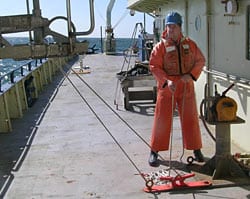Mike Carlowicz

Growing up in Edison, New Jersey, Mike Carlowicz wanted to
be an “-ologist.” First he wanted to be an archaeologist, then a meteorologist,
chemical engineer, and astronomer. Eventually he settled on biologist. At age 18,
he told a local reporter (in a story about being the youngest
American Legion baseball coach in the state) that he hoped “to find a cure for
something.” The only thing he has ever cured is boredom, as he rarely stays
with one topic or in one place long enough to wear it out.
While floundering in chemistry class at Georgetown
University, he decided that he was not cut out for the detail-driven
work of a scientist. He switched to an English major, though he really majored
in his college newspaper, The Hoya. He completely overlooked the fact
that writers are as rigorous and detail-driven about words as scientists are about data.
Two years into a journalism career at The Discovery Channel,
he served as ship’s naturalist among a group of
city-slicker editors sailing
on the Chesapeake Bay. While observing once-threatened ospreys
nesting on channel markers and watching engineers at war with
rising seas around Tangier Island, Virginia, Mike rediscovered his love of
science. He soon applied to
The Johns Hopkins University to study science writing, stunned that anyone
would
offer such a degree and curious why anyone would pay him to be a
lifelong
student.
So far, he has convinced scientists and experts in several fields–geophysics (Eos/American Geophysical Union), medicine (Clinical Laboratory News),
space
physics (NASA Goddard Space Flight Center), and oceanography—into
letting him write about their work. He has written three books springing
out of his NASA experience—Storms from the Sun
(Joseph Henry Press, 2002), The Sun (H.N. Abrams Books, June 2006), and The Moon (H.N. Abrams Books, June 2007). His next book adventure will rise out of the ocean or the ice.
Whether
teaching nonfiction or procrastinating instead of writing, Mike relishes every day
that he gets paid to talk to scientists and engineers, to learn how the planet and universe works,
and to observe the first draft of science history. Learn more about Mike…
Nothing Found
It seems we can't find what you're looking for. Perhaps searching can help.
